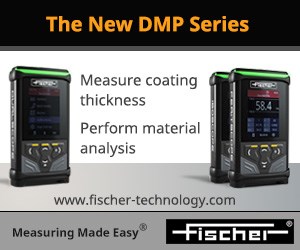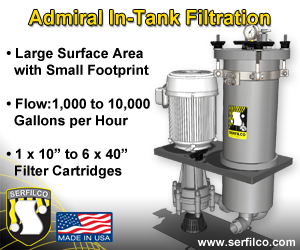Options to Improve Passivate and Chromite Coatings
How do you improve the quality of a passivate coating if there are mechanical limitations? MacDermid Enthone’s Adam Blakeley offers a detailed explanation.
Q. What options are available to improve the quality of a passivate coating if there are mechanical limitations?
A. I’ll focus on defining the passivate coating and maximizing its most crucial parameters and characteristics, including pH, concentration, agitation, immersion time, contamination and temperature.
Real-world plating facilities often fail to accommodate adjustments in passivate technology due to insurmountable restrictions in their existing lines. However, there are ways to manipulate these solutions without incurring substantial capital investment.
To increase the aggressiveness, reaction rate (speed) and activity of the passivate, take advantage of the following parameter values: lower pH, higher temperature, higher agitation level, longer immersion time, fresher solution (low built-up contaminants), higher concentration and fresher bright dip. To lower passivate aggressiveness, simply do the opposite.
Take, for example, a facility hemmed in by immersion times and/or temperature limitations. Slight modifications to pH and/or any of the other parameters listed above will increase the overall activity of the passivate, thus permitting proper film formation without drastic alterations to their current line setup. Here are some other considerations:
Passivate reaction. Trivalent chromium (tri-chrome) passivates are acidic solutions designed to partially dissolve metal (for example, a zinc deposit) upon immersion. This dissolution evolves hydrogen gas, which subsequently increases the pH at the interface between the solution and the part, which in turn precipitates the chromium constituents in the passivate, which then attach themselves and some of the other ingredients to the metal as a thin, gelatinous film. Many of the other chemical components act as activators, stabilizers, stimulants, complexants, buffering agents and catalysts.
pH. pH is the most critical parameter of the six mentioned, because it changes the most throughout the course of the plating cycle as work is being processed. A low pH, no matter the formula (high-build or blue-bright), lying outside the bounds of the recommended range, can be detrimental to the film, because this often results in purely dissolving the metal deposit and failing to form a film. High pHs induce an opposite effect, in that the film forms either too slowly, producing thin films, which impacts corrosion resistance, color and even adhesion (powdery), or no film is formed at all. ]
Concentration. Dragout is generally the fastest way a solution loses concentration, and the effect is more pronounced in those solutions that are made up at lower concentrations, which are often the blue-bright versions. Higher concentrations can help to alleviate contaminant buildup by the introduction of more chromium.
Agitation. The film will form faster with higher levels of agitation, because fresh solution is being brought into contact with the metal at the point that the reaction takes place. Agitation that is consistent and uniform produces the highest-quality coatings. Due to the softness of the film, barrel rotation speed should be limited to avoid damaging the coating through abrasion. The difficulty encountered with rack plating is that agitation levels are higher at the top, which creates a different coating both in color and thickness. Without agitation, it would take twice as long to achieve proper film thickness.
Immersion time. With all passivates, both bright and heavy-build iridescent, there is an optimum immersion time that is key for color, clarity, adhesion, brightness and thickness. Excessive time can produce unsightly discoloration (iridescence), powdery films and sometimes even thinner films. This is because the film begins to lose its integrity once the acidity no longer produces a film but begins to attack the film itself. Insufficient time without alterations to any other parameters will lead to thinner coatings, color variations and poor corrosion resistance.
Contamination. Zinc is an inevitable contaminant that will negatively impact passivate effectiveness but that can be overcome somewhat by increasing the concentration of the passivate, which will in turn increase the chromium content, which acts to counteract the zinc.
Iron contamination is common due to poor zinc coverage, especially on tubular steel parts. The acidic passivate attacks the steel leaching iron into the passivate. The threshold for many passivates is 100–500 ppm of iron, as it will begin to impact color uniformity and corrosion resistance.
Copper is even more pernicious and at much lower levels, leading to discoloration and heavy black bands in the recesses. Corrosion resistance can be catastrophically impacted with tolerances as low as 0.1 percent of the passivate’s chromium content, which is often less than
5 ppm, especially with blue-bright formulas.
Temperature. Temperature is the last catalyst used to enhance passivate film formation. Higher temperatures increase the speed and intensity of the reaction, which affects film thickness. However, rapid changes in temperature are uncommon. High-build passivates often require appreciable heat to ensure adequate reaction progress, but many passivates require no additional heat provided the ambient temperature is not colder than the minimum TDS requirement. Excessive heat can produce a thin and powdery film, but excessively low temperatures can produce thin or potentially no coating at all.
Bright dips. Bright dips are often neglected post-treatment options. They are dilute nitric or sulfuric acid, even hydrochloric, sulfamic and citric, designed to remove potential alkaline or organic films from the deposit to prepare it to receive the passivate uniformly and consistently, and to preserve the pH and cleanliness of the passivate tank, thus extending its longevity.
Given the information presented above, the applicator should have a better understanding of how passivates function, and can use that knowledge to adapt and amend those facets and components to achieve the color, film thickness and corrosion protection desired without resorting to extreme monetary investment, process innovation, or laborious instrumentation and retrofitting.
Related Content
A Chromium Plating Overview
An overview of decorative and hard chromium electroplating processes.
Read MorePossibilities From Electroplating 3D Printed Plastic Parts
Adding layers of nickel or copper to 3D printed polymer can impart desired properties such as electrical conductivity, EMI shielding, abrasion resistance and improved strength — approaching and even exceeding 3D printed metal, according to RePliForm.
Read MoreThe Importance of Strike Solutions
Electroplating strikes are used to improve adhesion and create a foundation for subsequent layers when plating. In this helpful article, Adam Blakeley of MacDermid Enthone offers an insightful guide to understanding electroplating strikes.
Read MoreProducts Finishing Reveals 2023 Qualifying Top Shops
Each year PF conducts its Top Shops Benchmarking Survey, offering shops a tool to better understand their overall performance in the industry. The program also recognizes shops that meet a set of criteria to qualify as Top Shops.
Read MoreRead Next
The 2024 Ford Mustang: All the Colors Available
Although Chevrolet has announced the end of the Camaro and Dodge is offering “Last Call” editions of the Charger and Challenger, the Ford Mustang is launching to its seventh generation.
Read MoreEpisode 42: An Interview with Robin Deal, Hubbard-Hall
Hubbard-Hall wastewater treatment specialist Robin Deal discusses the latest trends in wastewater management.
Read MorePowder Coating 4.0: Smarter, Faster, More Efficient and Connected
New tools reduce cost and waste, lower manufacturing footprint of powder coating operations.
Read More
























